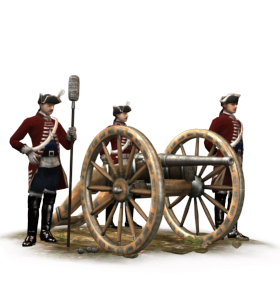Difference between revisions of "3-lber Horse Artillery (ETW Unit)"
Tango12345 (talk | contribs) (→Factions) |
(→Tactics) |
||
| Line 7: | Line 7: | ||
Historically, in many countries horse artillery developed a cavalry-like air of being an elite force. This attitude is entirely understandable. Dragging heavy artillery pieces across country at the gallop is an inherently dangerous thing to do, even without people shooting at you! | Historically, in many countries horse artillery developed a cavalry-like air of being an elite force. This attitude is entirely understandable. Dragging heavy artillery pieces across country at the gallop is an inherently dangerous thing to do, even without people shooting at you! | ||
| − | == | + | ==Details== |
| − | Horse artillery share many similarities with foot artillery: their ammunition types, their fire trajectories, etc. | + | Horse artillery share many similarities with foot artillery: their ammunition types, their fire trajectories, etc. However, they possess far firepower than their foot artillery counterparts in exchange for much better mobility: while foot artillery are easily the slowest unit type in the game, horse artillery can move almost as quickly as light cavalry. With their high speed, horse artillery can deploy firepower on crucial points of the battlefield much more quickly than foot artillery. Their lack of stopping power compared to their larger caliber cousins, however, mean that they are less suitable for direct engagements. These attributes mean that horse artillery are more suitable in an aggressive, mobile army makeup than a stationary one. |
==Factions== | ==Factions== | ||
Revision as of 21:10, 22 September 2011
Intended to keep up with rapidly-advancing mounted forces, horse artillery batteries have a touch of "cavalry dash" about them.
Overview
Horse artillery units are distinguished from other types of artillery forces because everyone rides into battle: drivers ride the horses, while gun crews are often given seats on the gun limbers. The cannons assigned to horse artillery units usually fire relatively small calibre rounds although, as always, the weight of shot is used to designate different horse artillery types. The weight of fire is considered to be less important than the speed with which it can be moved to a firing position, deployed, and then removed to a new site. This is what gives horse artillery its appeal to generals: the ability to rapidly give fire from almost anywhere on the battlefield. Horse artillery can be used as a flexible reserve, or to exploit a weakness in an enemy line.
Historically, in many countries horse artillery developed a cavalry-like air of being an elite force. This attitude is entirely understandable. Dragging heavy artillery pieces across country at the gallop is an inherently dangerous thing to do, even without people shooting at you!
Details
Horse artillery share many similarities with foot artillery: their ammunition types, their fire trajectories, etc. However, they possess far firepower than their foot artillery counterparts in exchange for much better mobility: while foot artillery are easily the slowest unit type in the game, horse artillery can move almost as quickly as light cavalry. With their high speed, horse artillery can deploy firepower on crucial points of the battlefield much more quickly than foot artillery. Their lack of stopping power compared to their larger caliber cousins, however, mean that they are less suitable for direct engagements. These attributes mean that horse artillery are more suitable in an aggressive, mobile army makeup than a stationary one.
Factions
 Great Britain
Great Britain United Provinces
United Provinces Austria
Austria Bavaria
Bavaria Gran Colombia
Gran Colombia Courland
Courland Denmark
Denmark France
France Genoa
Genoa Georgia
Georgia Greece
Greece Hannover
Hannover Hessen
Hessen Hungary
Hungary Ireland
Ireland Knights of St. John
Knights of St. John Louisiana
Louisiana Mexico
Mexico Naples & Sicily
Naples & Sicily New Spain
New Spain Norway
Norway Italian States
Italian States Savoy
Savoy Poland-Lithuania
Poland-Lithuania Portugal
Portugal Prussia
Prussia Quebec
Quebec Russia
Russia Saxony
Saxony Scotland
Scotland Spain
Spain Sweden
Sweden Thirteen Colonies
Thirteen Colonies United States
United States Venice
Venice Westphalia
Westphalia Württemberg
Württemberg
